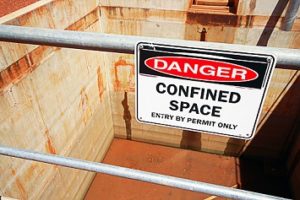In keeping with current trends in regulatory enforcement, Cal/OSHA has cited both a general contractor and a subcontractor for a confined space incident that led to a worker’s death in October 2016.

BentheBeeMan / iStock / Getty Images Plus / Getty Images
The general contractor was building a single-family residence in Bel Air and hired a subcontractor to install and service reinforced concrete posts on the property. As part of that work, a 27-year-old laborer was being lowered into a drainage shaft to clean out mud and debris. The worker was lowered into the 50-foot (ft) shaft in a bucket attached to a minicrane; he was not wearing personal fall protection. About 10 ft down, the worker entered an oxygen-deficient atmosphere. He lost consciousness and fell to the bottom of the shaft, where he drowned in 1 ft of water.
According to Cal/OSHA, neither the general contractor nor the subcontractor followed permit-required confined space procedures that could have prevented the worker’s death. The agency has proposed a total of $352,570 in fines against the employers for multiple workplace safety and health violations, including 10 serious and 3 willful category violations.
The subcontractor was cited for 13 violations carrying $337,700 in fines, including two willful serious accident-related, one willful serious, one serious accident-related, and six serious violations. The accident-related violations were for the company’s failure to:
- Ensure safe entry into the confined space;
- Have an effective method to rescue the worker in the confined space in an emergency; and
- Test the environment to determine if additional protective equipment, such as a respirator or oxygen tank, were required to work safely in the shaft.
The general contractor was cited for five violations, three of them serious, carrying $14,870 in fines. The general contractor allegedly failed to:
- Evaluate the worksite for possible permit-required confined spaces;
- Ensure that the subcontractor met all requirements to comply with a permit space program; and
- Protect workers from the hazard of impalement by guarding all exposed reinforced steel ends that extend up to 6 ft above the work surface with protective covers.
Liability on Multiemployer Worksites
Under California Labor Code Section 6400(b), a “multiemployer worksite” is defined as “any work site where more than one employer and their employees work, not necessarily at the same time.” Construction sites, like the Bel Air site discussed above, are the most common multiemployer worksites.
Employers can be cited for hazards based on the role(s) that they play on the site. A single employer may fall into one or more of the categories of controlling employer, creating employer, exposing employer, or correcting employer.
A “controlling employer” is an employer that has general supervisory authority over the worksite, including the power to correct safety and health violations or require others to correct them.
A “creating employer” is an employer that causes a hazardous condition that violates a Cal/OSHA standard. Employers that create a violative condition are citable even if the only employees exposed are those of other employers at the site.
An “exposing employer” is an employer whose own employees are exposed to the hazard. An exposing employer that also created the violation is citable for the violation as a creating employer.
A “correcting employer” is responsible for correcting a hazard. Correcting employers have usually been given the responsibility of installing and/or maintaining particular safety/health equipment or devices. The correcting employer must exercise reasonable care in preventing and discovering violations and meeting its obligations to correct the hazard.
If you have employees at a multiemployer worksite, you should know which category or categories apply to you and the responsibilities that are assigned to each category. Be aware of where your liability lies.
